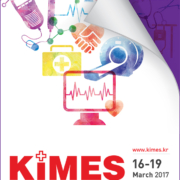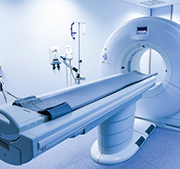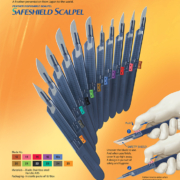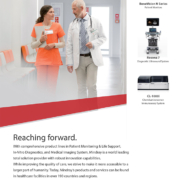Imaging centre boosts patient care services in Sicily
With investments in two new, top-of-the-line DR solutions plus the innovative Portal, the imaging centre owned by Dr. Francesco Fiumara offers a higher level of healthcare service in Sicily, Italy.
Established in 1986, the Centro di Diagnostica per Immagini Dr. Francesco Fiumara is today recognized as the best diagnostic centre in the eastern region of Sicily, and is contributing to enhancing the level of healthcare services in the area. As a private clinic fully dedicated to diagnostic imaging, and accredited by the Italian National Healthcare System, it must offer first-rate services while controlling costs. Agfa HealthCare’s solutions have been key in helping the clinic achieve this goal.
Spread over two floors and 1,200 m2 of a building in Santa Teresa di Riva, some 40 km from Messina, Sicily, the diagnostic imaging clinic carries out diagnostic imaging and medical examinations for about 150 patients every day. The clinic strives to offer patients high-quality services, delivered with competence and compassion. This is reflected in the extended 8 am to 8 pm opening hours, the team of 14 specialists in a total staff of 40, and the use of the most advanced imaging technologies: including digital radiography, mammography, CT, ultrasound and MRI.
The clinic was already a customer of Agfa HealthCare; based on this positive experience, in 2015 it installed the DX-D 800 and DX-D 300 direct radiography (DR) systems. These have supported the clinic to increase and improve its radiology services as well as to reduce patient radiation dose. The clinic also implemented Agfa HealthCare’s Portal solution, giving patients the ability to remotely access and share their own exams.
A broad range of high-quality, dedicated exams
The centre performs a broad range of digital exams. One of the four radiography rooms contains a DR system specifically for mammography, while another is used for dental radiography. The last two rooms house the two new Agfa HealthCare DR systems, used for skeletal imaging, and for digestive and urogenital imaging using contrast media.
The DX-D 300 is installed in the skeletal radiography room; its fully-motorized arm easily accommodates a number of configurations, making it ideal for orthopedic studies. The remote-controlled DX-D 800 can handle general radiography and fluoroscopy, and has a detachable, tethered detector for portable exposures. “We only needed one investment to handle a broad range of applications,” says Dr. Fiumara, owner of the centre. The system is used for functional examinations such as barium enemas and esophagus tests.
Increased efficiency and faster throughput
“Diagnostic radiography has become a strategic service for our clinic to offer. We began working with Agfa HealthCare on this project in 2009, installing the IMPAX RIS/PACS solution, which was continuously updated in the following years. With these tools, we could already increase the efficiency of our imaging workflow and archive all patient exams in our database.”
The centre was one of the first in Sicily to adopt digital radiology. “We installed our first Agfa HealthCare computed radiography (CR) system, the DX-S, in 2012,” says Dr. Fiumara. “Our CR solution was a big innovation in efficiency and quality compared to conventional radiography. The challenge was to keep up a high standard of image quality while simultaneously reducing examination time and – consequently – patient waiting times.”
Once the clinic had experienced the quality of Agfa HealthCare’s technology and support services, Dr. Fiumara was keen to continue this partnership. “Working with Agfa HealthCare makes us feel confident for the future.”
“We considered several aspects when we were looking at the Agfa HealthCare DR solutions,” confides Dr. Fiumara. “Reducing exam time was a significant attraction, but so were the high resolution and the MUSICA image processing software. So we chose both the DX-D 300 and DX-D 800.”
“With these two DR solutions we have increased the number of exams we can perform every day, and at the same time we have enhanced our imaging reputation.”
The agreement with Agfa HealthCare includes full 24-hour service with a local engineer for any hardware problems and remote support for the software. “We have a single point of contact, so if something goes wrong I can directly speak to the technical contact and have an immediate solution,” continues Dr. Fiumara. Expertise in operations and workflow is another advantage; he says: “The specialized knowledge of the local technical and commercial Agfa HealthCare team is very valuable and helps us identify specific needs.”
Reducing patient dose
“As we learned more about dose reduction, we started to look for dose reduction potential in all our radiography systems. This became our strategic objective.”
The clinic’s four digital radiology systems and CT system all feature very low levels of radiation dose. “The I-Dose system in the CT device, for example, reduces dose by 60%. That’s the highest reduction we have reached so far with our devices.”
“Patients today are better informed and ask questions about patient dose. We are proud to offer not only an efficient and high-level radiology service, but also the safest in our area,” continues Dr Fiumara.
A Portal to better patient care and satisfaction
To further expand its patient services, Dr. Fiumara implemented the Agfa HealthCare Portal solution, which gives patients access to information from different sources inside and outside the hospital. This overview of information and actions can help enhance operational efficiency while improving the overall patient experience. “Integrating the Portal with the RIS/PACS solution means patients can access their exams and get an online consultation, instead of needing to return to the clinic just for this. It also speeds up a therapy.”
Patients can look at their own images, results and other aggregated information; and can share them in a secure way with a caregiver or another doctor. By empowering and satisfying patients, the Portal will also support the clinic to increase patient loyalty and to attract new patients.
“With our Agfa HealthCare solutions, we can offer a higher-quality service to patients, with low downtime,” concludes Dr. Fiumara. “We have increased the number of exams we conduct, whilst reducing our costs. Our partnership with Agfa HealthCare puts us in a better position for further growth.”
*DX-D 800 is not available in the US and Canada










